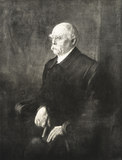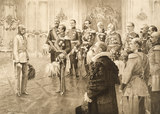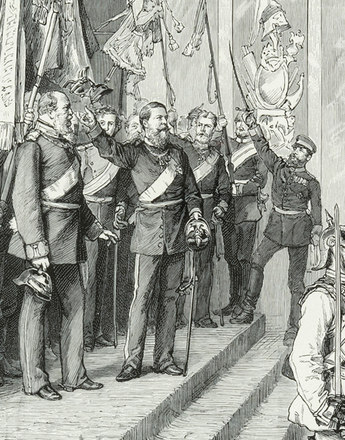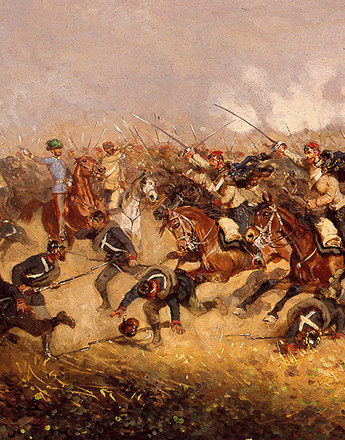-

Bismarck. Based on a painting by F. von Lenbach
Copyright: Schloß Schönbrunn Kultur-und Betriebsges.m.b.H./Fotograf: Alexander E. Koller
-

Wilhelm Gause: Emperor Franz Joseph visiting Bismarck 1889, drawing, 1908
Copyright: Schloß Schönbrunn Kultur-und Betriebsges.m.b.H./Fotograf: Alexander E. Koller
-

Wilhelm Gause: The German Princes congratulate the Emperor on the 60th anniversary of his reign, illustration, 1908
Copyright: Schloß Schönbrunn Kultur-und Betriebsges.m.b.H./Fotograf: Alexander E. Koller
In response to the question of national unification, many Germans considered that the logical path was for the German Confederation to be made into a federal state and then into a German nation-state. Nevertheless, the question of the role to be played by the Habsburg Monarchy was a major problem.
Austria’s involvement in the context of unification automatically put the Habsburg Monarchy in a dangerous situation as it meant that it was competing with Prussia for the leading position in the overall process. And when the unification of Germany came, it was to have even more far-reaching effects on the Monarchy’s internal stability.
There were two possible solutions to the problem, both of which were a threat to the Habsburg Monarchy’s existence. The first was the so-called ‘smaller-German solution’, that is to say, the unification of the German-speaking lands but without Austria. In Vienna there was justifiable anxiety that if this course was taken, the Germans within Austria would develop separatist tendencies, which would of course be a major problem for the Habsburg Monarchy.
The second scenario was the ‘greater-German solution’, in which Austria was to be included. This solution, however, was problematic because of the multi-ethnic composition of the Habsburg Monarchy, as only certain parts of Austria would be involved, namely, the Alpine and Danube lands and the lands of the Bohemian crown, all of which had been part of the Holy Roman Empire until its dissolution in 1806. As the remaining parts of the Monarchy had non-German-speaking majorities, they would have been excluded, which would have broken up the territorial unity of the Habsburg Monarchy.
Consequently, Vienna decided to pursue neither course but simply aim to maintain a delicate balance in its relations with the German states.
The spirit of the time, however, was not on Austria’s side, for the German drive for unification was becoming an increasingly important issue in the public sphere. In Austria, the ‘greater-German solution’ was supported not only by the German nationlists but also by the radical democrats, who shared the nationalists’ goal of throwing off the chains of feudalism and dynastic paternalism. Now both these groups were in favour of Austria becoming fully incorporated in the new Germany, even if this meant the end of the Habsburg Monarchy.
After 1848 the Habsburgs effectively gave up hope of maintaining their leading position in the German-speaking world and the reign of Emperor Franz Joseph ushered in a period of weakness in the diplomatic sphere. On the internal front the Monarchy gave up the goal of gradual transformation into a German state and ratified the principle of ‘equality of the peoples’ with its positive commitment to the concept of a multi-national state. As a result, however, the Germans now became just one nationality among many within the borders of the Habsburg Monarchy.
This decision finally led to the crisis in Prussian-Austrian relations that culminated in Austria’s defeat at the battle of Königgrätz in 1866. Thereafter Austria had definitely lost its leading position in the German-speaking world to Bismarck’s Prussia and there were no longer any obstacles to the ‘smaller-German solution’, which was finally realized in 1871 in the proclamation of the German Reich in the Hall of Mirrors at Versailles.
Translation: Peter John Nicholson
Doering-Manteuffel, Anselm: Die deutsche Frage und das europäische Staatensystem 1815 bis 1871 (Enzyklopädie deutscher Geschichte 15), München 1993
Kann, Robert A.: Zur Problematik der Nationalitätenfrage in der Habsburgermonarchie 1848–1918, in: Wandruszka, Adam/Urbanitsch, Peter (Hrsg.): Die Habsburgermonarchie 1848–1918, Band III: Die Völker des Reiches, Wien 1980, Teilband 2, 1304–1338
Rumpler, Helmut: Eine Chance für Mitteleuropa. Bürgerliche Emanzipation und Staatsverfall in der Habsburgermonarchie [Österreichische Geschichte 1804–1914, hrsg. von Herwig Wolfram], Wien 2005
Stourzh, Gerald: Die Gleichberechtigung der Nationalitäten in der Verfassung und Verwaltung Österreichs 1848 bis 1918, Wien 1985
Sutter, Berthold: Die Deutschen, in: Wandruszka, Adam/Urbanitsch, Peter (Hrsg.): Die Habsburgermonarchie 1848–1918, Band III: Die Völker des Reiches, Wien 1980, Teilband 1, 154–339
-
Chapters
- The German-Austrians in the Habsburg Monarchy
- German Austrians or Austrian Germans?
- Holding the Monarchy together: The German-Austrians as the guarantors of Habsburg statehood
- In search of the Fatherland: The genesis of the German nation
- To join or not to join? Austria and the process of German unification
- Fear of losing hegemony: The German-Austrians in the Austrian multi-national state
- The radical German nationalists and their attitude to the Habsburg Monarchy
- The concept of ‘German Central Europe’






